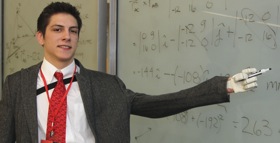Cheap, printable prosthetic hand wins top prize at 2012 Innovation Days
A prosthetic hand that could be cheaply created on a 3-D printer for amputees in developing countries won the top prize and $10,000 in the Schoofs Prize for Creativity, one of a pair of competitions that make up Innovation Days. Held Feb. 9 and 10, the event rewards University of Wisconsin–Madison students for creative and marketable ideas.

Engineering student Eric Ronning demonstrates his winning invention, the Manu Print.
Manu Print has a unique design that allows users to close and open each finger individually by applying only one tensile force. The hand is purely mechanical and has no electronic parts. Inventor Eric Ronning, a mechanical engineering sophomore, could make the hand’s design available on open-source 3-D printing sites such as Thingiverse, where it could be easily replicated for about $20.
The Manu Print also is more aesthetically pleasing and similar to the human hand than the most-used design on the market. Currently available prosthetics are either poor at fine-motor uses, or too expensive to be accessible to most of the people who need them. The most utilitarian design available costs about $600.
As a student in a sophomore-level statics course, Ronning was inspired by engineering physics professor Mike Plesha’s encouragement to his students to think outside the classroom for applications for their ideas.
Ronning first came up with the idea of a mechanism that allows each finger to move with a separate, differential force. Then it was just a matter of finding a good application for the idea. He eventually decided on prosthetic hands, particularly for people who couldn’t afford what was already on the market. “I wanted to do some good,” he says.
Of the 25 million amputees in the world, 80 percent are in developing nations, and more than 200,000 people lost limbs in the 2010 Haiti earthquake alone.
“I needed a strong core motivator to keep me putting those hours in the shop,” says Ronning. “If it was just the dollar signs, I wouldn’t have.”
He said the idea of printing the hand, rather than manufacturing it, was fueled in part by an engineering class he took in high school, where he learned 3-D modeling and computer-assisted design.
In addition to the top Schoofs Prize, Ronning also won second place and $1,250 in the Tong Prototype Competition, which rewards students for building their ideas.
The winner of the Tong Prototype Prize, the second major Innovation Days competition, was mechanical engineering senior Scott Johanek, who created NoVo Luggage, a high-end, durable suitcase that can roll in any direction but also not tip over. He earned $2,500 for his efforts.
Johanek, who entered a different omni-directional suitcase in the 2011 Innovation Days competition, says he went back to the drawing board to create something completely different in 2012. The result: a product that has the high-end look of a soft-sided bag, but a much more solid, lightweight carbon frame and customizable compartment sizes, with textiles only as covers. “I’m a guy who always wants to make things better,” he says.
So, he combined the best features of bags already on the market, as well as the unique wheel structure.
Although he plans to be an entrepreneur and is focusing on learning the business side of producing a product, Johanek says having an engineering background would be key in selling his designs. “I know everything about this product. I designed it, I tested it, and I can tell you why you should buy it,” he says.
Johanek says his company, Clerisy Innovation Studios, hopes to have the NoVo Luggage on the market by October.
In addition to the top Tong Prize, Johanek also won second place and $7,000 in the Schoofs Prize for Creativity.
Peter Tong, who sponsors the prize, says a good prototype is a key part of the innovation process. He was pleased to see that many of this year’s entrants were using new 3-D printing tools to create them. “If you don’t have something to put down in front of a prospective customer, you can’t connect to them,” he says. “It’s very rewarding to see this taking place at a university level.”
Past Innovation Days participants have gone on to create businesses based on their innovations. “I think you’ll find it pays off enormously as you go forward,” College of Engineering Dean Paul Peercy told competition participants. “You guys are role models to your peers. You have illustrated that anyone can innovate.”
Other Schoofs Prize winners include:
Second place and $7,000: NoVo Luggage.
Third place and $4,000: The DualX Fracture Fixation System, a lightweight kit for stabilizing broken arms and legs quickly and comfortably for patients in the emergency room. Invented by mechanical engineering senior Tom Gerold and biomedical engineering senior Marc Egeland.
Fourth place and $1,000: Clean Coal, an electric heat source for burning tobacco in hookahs that activates when a user inhales, simulating a real coal but without the mess. Invented by biological systems engineering junior Justin Vannieuwenhoven.
Other Tong Prototype Prize winners include:
Second place and $1,250: Manu Print.
Third place and $700: Javi, a programming tool that allows people who use LabVIEW, a programming environment for control and measurement systems, in tandem with an easy-to-use Java-based program. For example, cell biologists could control several microscopy instruments’ software from a central program. Invented by computer engineering student Matthew Kirk.
Additional prize winners include:
Sorenson Best Design Notebook Award and $1,000: The TabTop Double Tablet Laptop, an apparatus for physically and electronically linking two tablet computers to simulate a laptop or other multipurpose configurations. Invented by mechanical engineering student Michael Szewczyk.
Younkle Best Presentation Award and $1,000: DualX Fracture Fixation System.
Enjoy this story?
Read more news from the College of EngineeringSubscribe to Wisconsin Ideas
Want more stories of the Wisconsin Idea in action? Sign-up for our monthly e-newsletter highlighting how Badgers are taking their education and research beyond the boundaries of the classroom to improve lives.
